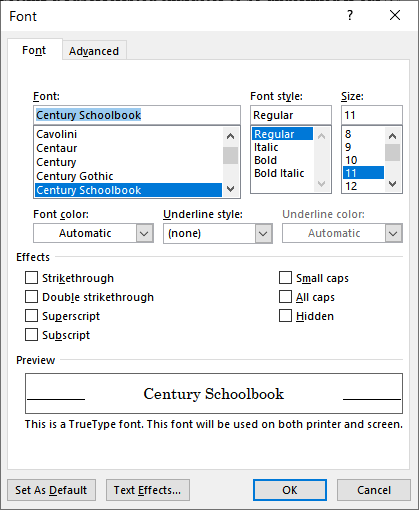Please Note: This article is written for users of the following Microsoft Word versions: 2007, 2010, 2013, 2016, 2019, 2021, and Word in Microsoft 365. If you are using an earlier version (Word 2003 or earlier), this tip may not work for you. For a version of this tip written specifically for earlier versions of Word, click here: Creating Custom Underlines.
Written by Allen Wyatt (last updated April 9, 2022)
This tip applies to Word 2007, 2010, 2013, 2016, 2019, 2021, and Word in Microsoft 365
When it comes time to underlining some of the text in a document, many people rely on the Underline tool on the Home tab of the ribbon (in the Font group). This applies one type of underline, but Word has more than one type of underline you can use. You can see some of those underlining styles (eight of them) by clicking the down-arrow at the right of the Underline tool. If you want even more underlining styles, click the down-arrow and then click More Underlines. Word displays the Font tab of the Font dialog box. (See Figure 1.)

Figure 1. The Font tab of the Font dialog box.
Note that the dialog box includes a drop-down list entitled Underline Style. Click on the list and you can choose any of 18 ways to underline your text (including "None and Words Ony"). For some people, this variety still might not be enough. For instance, you may want to underline your text using fine dots, rather than a dashed underline or heavy dotted underline, both of which are options in the Underline Style drop-down list.
This is where it would be nice to create custom underlines in Word. Unfortunately, there is no way to do this. You could, of course, use the drawing capabilities of Word to create just the type of lines you want, but you would need to place them individually and then move them if your text moves.
A better solution, particularly if you will be doing lots and lots of underlining in a particular manner, is to create your own font that incorporates just the type of underlining you need. Using a font editor (there are many on the market) you can pick whatever font you want, modify that font to include the underlines, and then save the font under a new name. When you want the custom underline, just switch the font on the selected text.
Of course, if you create a custom font and then share the document with others, you will either need to make sure that the others also have the font or you'll need to embed the font within the document (as described in other issues of WordTips).
WordTips is your source for cost-effective Microsoft Word training. (Microsoft Word is the most popular word processing software in the world.) This tip (9861) applies to Microsoft Word 2007, 2010, 2013, 2016, 2019, 2021, and Word in Microsoft 365. You can find a version of this tip for the older menu interface of Word here: Creating Custom Underlines.

Create Custom Apps with VBA! Discover how to extend the capabilities of Office 365 applications with VBA programming. Written in clear terms and understandable language, the book includes systematic tutorials and contains both intermediate and advanced content for experienced VB developers. Designed to be comprehensive, the book addresses not just one Office application, but the entire Office suite. Check out Mastering VBA for Microsoft Office 365 today!
Need to change the color you previously used to highlight text in your document? You can use Word's Find and Replace tool ...
Discover MoreHighlighting text, using the Highlight tool, is a great way to mark up a document. Normally you need to use the toolbar ...
Discover MoreWord gives you control over how your text appears on the page. This includes adjusting how close letters are to each ...
Discover MoreFREE SERVICE: Get tips like this every week in WordTips, a free productivity newsletter. Enter your address and click "Subscribe."
There are currently no comments for this tip. (Be the first to leave your comment—just use the simple form above!)
Got a version of Word that uses the ribbon interface (Word 2007 or later)? This site is for you! If you use an earlier version of Word, visit our WordTips site focusing on the menu interface.
Visit the WordTips channel on YouTube
FREE SERVICE: Get tips like this every week in WordTips, a free productivity newsletter. Enter your address and click "Subscribe."
Copyright © 2025 Sharon Parq Associates, Inc.
Comments